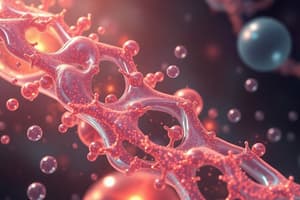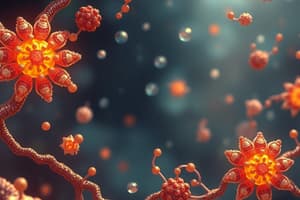Podcast
Questions and Answers
What is produced during each round of β-oxidation?
What is produced during each round of β-oxidation?
- 1 NADH and 1 FADH2 (correct)
- 2 NADH and 2 FADH2
- 1 ATP and 1 Acetyl CoA
- 1 Acetyl CoA and 2 NADH
In the oxidation of palmitic acid (16:0), how many Acetyl CoA units are formed?
In the oxidation of palmitic acid (16:0), how many Acetyl CoA units are formed?
- 8 (correct)
- 9
- 6
- 7
What happens to propionyl CoA formed during the oxidation of margaric acid (17:0)?
What happens to propionyl CoA formed during the oxidation of margaric acid (17:0)?
- It produces additional NADH
- It is discarded as waste
- It forms Succinyl CoA (correct)
- It is converted into Acetyl CoA
What is the energy yield from one palmitic acid molecule in terms of ATP?
What is the energy yield from one palmitic acid molecule in terms of ATP?
Which of the following is a starting material for fatty acid synthesis?
Which of the following is a starting material for fatty acid synthesis?
What is the primary characteristic of lipids?
What is the primary characteristic of lipids?
Which of the following is NOT a role of lipids?
Which of the following is NOT a role of lipids?
What type of lipid is primarily responsible for energy storage in adipose tissue?
What type of lipid is primarily responsible for energy storage in adipose tissue?
Which fatty acid configuration is depicted with both a hydrophilic and hydrophobic side?
Which fatty acid configuration is depicted with both a hydrophilic and hydrophobic side?
What is one of the major types of lipids mentioned in the content?
What is one of the major types of lipids mentioned in the content?
Which of the following lipids serves as a backbone for fatty acids?
Which of the following lipids serves as a backbone for fatty acids?
What class of lipids includes sphingolipids and phospholipids?
What class of lipids includes sphingolipids and phospholipids?
Which fatty acid configuration is typically used for cell signaling?
Which fatty acid configuration is typically used for cell signaling?
What is the backbone structure of sphingophospholipids?
What is the backbone structure of sphingophospholipids?
Which of the following lipids is NOT a product of lipid digestion?
Which of the following lipids is NOT a product of lipid digestion?
What role do bile salts play in lipid digestion?
What role do bile salts play in lipid digestion?
Which lipoprotein is responsible for transporting triacylglycerols after absorption in the intestine?
Which lipoprotein is responsible for transporting triacylglycerols after absorption in the intestine?
Which enzyme is primarily responsible for lipid digestion in the intestine?
Which enzyme is primarily responsible for lipid digestion in the intestine?
In fatty acid oxidation, what is the first step that occurs?
In fatty acid oxidation, what is the first step that occurs?
What are the products of lipid digestion involving phospholipids?
What are the products of lipid digestion involving phospholipids?
Which type of fat-soluble vitamins is absorbed along with lipids during digestion?
Which type of fat-soluble vitamins is absorbed along with lipids during digestion?
Flashcards
β-oxidation
β-oxidation
The breakdown of fatty acids into acetyl-CoA molecules, which can then be used for energy production.
Beta Oxidation Cycle
Beta Oxidation Cycle
A repetitive process that removes two carbon atoms (as acetyl-CoA) from a fatty acid in each cycle.
Fatty Acid Activation
Fatty Acid Activation
The initial step in fatty acid oxidation, where a fatty acid is activated by attaching coenzyme A.
Fatty Acid Synthesis
Fatty Acid Synthesis
Signup and view all the flashcards
Propionyl CoA
Propionyl CoA
Signup and view all the flashcards
What are lipids?
What are lipids?
Signup and view all the flashcards
What are the roles of lipids?
What are the roles of lipids?
Signup and view all the flashcards
What are fatty acids?
What are fatty acids?
Signup and view all the flashcards
What are triacylglycerols?
What are triacylglycerols?
Signup and view all the flashcards
What are phospholipids?
What are phospholipids?
Signup and view all the flashcards
What are steroids?
What are steroids?
Signup and view all the flashcards
What are lipoproteins?
What are lipoproteins?
Signup and view all the flashcards
What is beta-oxidation?
What is beta-oxidation?
Signup and view all the flashcards
Phospholipids
Phospholipids
Signup and view all the flashcards
Sphingophospholipids
Sphingophospholipids
Signup and view all the flashcards
Glycolipids
Glycolipids
Signup and view all the flashcards
Steroid Hormones
Steroid Hormones
Signup and view all the flashcards
Lipid Catabolism
Lipid Catabolism
Signup and view all the flashcards
Lipid Transport
Lipid Transport
Signup and view all the flashcards
Lipoproteins
Lipoproteins
Signup and view all the flashcards
Lipid Digestion
Lipid Digestion
Signup and view all the flashcards
Study Notes
Lipids Overview
- Lipids are water-insoluble (hydrophobic) molecules that dissolve readily in organic solvents.
- Lipids play crucial roles in energy storage, membrane structure, and signaling.
- They contain less water than carbohydrates (CHO) for the same amount of energy storage.
- Lipids are essential components of cell membranes.
- Lipids are involved in various signaling pathways, including hormone signaling.
- Lipids help with thermal insulation.
Types of Lipids
- Fatty acids
- Waxes
- Steroids
- Phospholipids
- Sphingolipids
- Triacylglycerides
- Terpenes
- Eicosanoids
- Ceramides
Roles of Lipids
- Lipids are a major source of energy storage.
- Lipids are essential components of cell membranes.
- Lipids are involved in signaling pathways, including hormonal signaling.
- Lipids provide thermal insulation.
Lipid Digestion and Absorption
- Digestion involves breaking down lipids into smaller pieces.
- Absorption occurs in the small intestine where lipids are absorbed.
- Digestion starts in the mouth with enzymes like lingual lipase.
- Stomach contains gastric lipase enzymes.
- Pancreas secretes pancreatic lipase.
- Bile salts emulsify lipids, crucial for digestion, decreasing the surface tension of fat globules.
Important Lipids
- Free Fatty Acids
- Triacylglycerols
- Phospholipids
- Glycolipids
- Cholesterol
Lipid Structure
- Amphipathic molecules with both hydrophilic (water-loving) and hydrophobic (water-fearing) regions.
- Lipid solubility and transport are directly related to their amphipathic nature.
- Lipoproteins: complex structures that transport lipids in the blood (like chylomicrons, VLDL, LDL, and HDL).
Lipid Catabolism
- Breakdown of lipids for energy.
- Glycerol is broken down into glycolysis intermediates.
- Fatty acids are broken into acetyl-CoA units.
- Number of carbons in the fatty acid chain dictates the energy yield.
Fatty Acid Oxidation
- Activation – adding CoA to the fatty acid.
- Transport to Mitochondria – carnitine shuttle.
- β-oxidation – repeated removal of 2-carbon units as acetyl-CoA.
Fatty Acid Synthesis
- Occurs in the cytoplasm.
- Uses acetyl CoA and NADPH as starting materials.
- Primary stages include: acetyl-CoA transport, malonyl-CoA synthesis, elongation of fatty acid chains.
Lipoproteins
- Lipoproteins are complexes that transport fats and cholesterol throughout the body.
- Different types of lipoproteins exist, each with varying densities and roles in transport and function.
- Their composition dictates their roles, especially their roles in carrying lipids.
Steroids
- Lipids with a characteristic four-ring structure, such as cholesterol, estradiol, testosterone.
- Cholesterol is a critical component of cell membranes.
- Steroids can function as hormones; for example, estradiol and testosterone.
Metabolic Processes and Functions of Different Lipids (Summary)
- The metabolic pathways for various lipids depend on these differences in structure.
- Lipids enter the energy production pathways at different stages, producing ATP and reducing agents.
- Different lipids serve different crucial functions in the body.
Studying That Suits You
Use AI to generate personalized quizzes and flashcards to suit your learning preferences.




